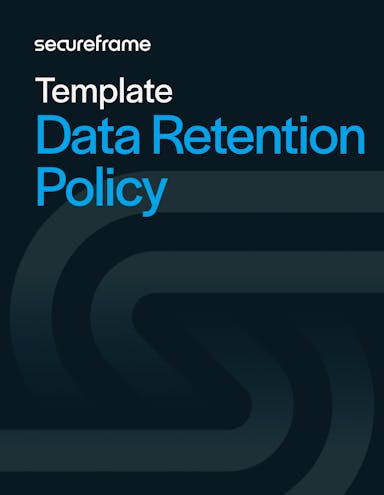
Creating a Data Retention Policy: Examples, Best Practices & Template
Anna Fitzgerald
Senior Content Marketing Manager
Rob Gutierrez
Senior Cybersecurity and Compliance Manager, CISA, CCSK, CMMC RP
Managing data effectively is critical in today’s regulatory environment and technology landscape. A well-crafted data retention policy can help organizations protect sensitive information, meet compliance requirements, and streamline their operations.
This policy is even more important now that AI adoption is driving up data retention times and changing data retention requirements. According to a survey by Seagate and Recon Analytics, 90% of business leaders who have adopted AI believe longer data retention improves the quality of AI outcomes and 93% claim data retention requirements have changed due to the implementation of AI.
This blog will explore what a data retention policy is, provide templates and examples, and outline best practices for creating your own so you can minimize data exposure and manage the data lifecycle effectively.
What is a data retention policy?
A data retention policy addresses how long an organization retains specific types of data, how that data is stored, and when it should be securely deleted. This policy helps ensure compliance with legal and regulatory requirements while reducing the risks associated with holding unnecessary data.
For example, one of the PCI DSS requirements stipulates having data retention and disposal policies in place to minimize storage duration and securely remove data that is no longer needed. ISO 27001 also has requirements for the “Protection of Records,” including establishing guidelines for record storage and disposal and maintaining a retention schedule for all records. Some frameworks require certain data be stored or retained for at least one year.
Let’s take a closer look at the benefits of a data retention policy.
Recommended reading

How to Write an ISO 27001 Data Retention Policy + Template
Why have a data retention policy?
A data retention policy is more than just a good business practice—it’s a critical component of a well-managed organization. It ensures that data is stored, managed, and disposed of effectively while aligning with legal, operational, and security requirements.
Here are some key benefits of having a data retention policy in place:
1. Compliance with laws and frameworks
Regulations such as GDPR, PCI DSS, HIPAA, and other frameworks mandate strict rules for how long organizations should retain certain types of data. A data retention policy ensures you stay compliant with these regulatory requirements, helping you avoid hefty fines, legal disputes, and reputational damage.
For example, one of GDPR’s data privacy principles is that businesses only keep personal data only as long as necessary for the purpose it was collected. A clear data retention policy helps you adhere to such principles.
2. Reducing risk and impact of data breaches
The less data you store, the lower the risk of exposure during a data breach. By eliminating outdated or unnecessary data, a data retention policy minimizes the volume of sensitive information vulnerable to cyberattacks. Even if a breach occurs, the impact is less severe because only limited data is retained.
3. Improving business continuity
By defining what data should be stored and for how long, a data retention policy streamlines data organization and management. This ensures that critical information is available when needed—such as during a disaster recovery scenario—thereby improving business continuity and minimizing downtime.
4. Enhancing data quality
Outdated, duplicate, or irrelevant data clutters storage systems, making it harder to find and use valuable information. A data retention policy helps organizations regularly purge unnecessary data, ensuring that retained data is accurate, relevant, and high-quality. This improves decision-making and operational efficiency.
5. Optimizing storage costs and efficiency
Storing excessive amounts of data can lead to unnecessary costs, whether it’s on-premise storage or cloud-based solutions. By retaining only the data you need and disposing of the rest, you can significantly reduce storage expenses and improve system performance.
6. Establishing accountability and transparency
A data retention policy provides clear guidelines for employees and stakeholders, ensuring everyone understands their responsibilities regarding data management. This transparency builds trust with customers, clients, and regulators, demonstrating your commitment to ethical and lawful data practices.
Implementing a data retention policy not only safeguards your organization but also strengthens its ability to adapt to changing regulatory and business demands. It’s a proactive step toward achieving compliance, security, and operational excellence.
Now that we understand its importance, let’s look at a sample policy.
Sample data retention policy
To illustrate what information a data retention policy should include and how it’s structured, let’s break down an example inspired by the Virginia Office of Data Governance and Analytics:
Purpose
A data retention policy typically begins with defining the objective of the policy, such as ensuring compliance with state or federal laws.

Scope
Next, the policy should specify who and what assets or data it applies to. It may apply to all assets utilized by all employees, contractors, and third parties on behalf of your organization.

Data retention periods
The policy should outline how long each type of data is stored. For example, financial records may be retained for seven years, while marketing data is kept for three years. If all data should be kept for a certain period of time, that should be defined as well.

Data disposal
The policy must include methods for securely deleting data once the retention period expires, such as encryption-based deletion. This section may be titled data disposal, data destruction, data deletion, or something similar.

Responsibility, Review, and Audit
A data retention policy will also typically include several sections covering:
- The responsibility of all employees to comply with this policy
- What will happen if employees do not comply
- How to report policy violations
- How often this policy will be reviewed and updated

Now that we have a better sense of what a data retention policy covers, let’s break down the step-by-step process for creating one.
How to create a data retention policy
Creating a data retention policy involves thoughtful planning and careful consideration of legal, regulatory, and business needs. Follow these steps to ensure your policy is comprehensive and effective:

1. Identify and classify the types of data your organization collects
Begin by cataloging all data your organization collects, stores, and processes. This may include:
- Customer data
- Employee data
- Intellectual property
- Operational data
- Supplier and vendor records
- Protected health information (PHI)
- Educational records
- Email and communications records
- Financial and tax records
- Personal data
- Federal data
- Security data
Next, classify this data by its sensitivity and purpose to understand its retention needs. This foundational step ensures your policy addresses every type of data and data sensitive level your organization handles.
Recommended reading

Data Classification: Explaining the What, Why, and How [ + Free Template]
2. Determine legal and regulatory requirements
Research the data retention laws and regulations relevant to your industry, location, and the data you process. For example, healthcare organizations in the US must comply with HIPAA, while financial institutions may need to adhere to SOX. Other organizations may need to comply with GDPR if collecting and processing personal information from European Union (EU) residents.
Understanding these obligations prevents non-compliance risks and ensures data is retained or deleted in accordance with legal mandates.
3. Establish retention periods for each data type
Set clear retention timelines for every type of data based on its legal, operational, and historical value. For example, financial records may need to be kept for seven years for tax purposes, while marketing data might only be retained for 12 months. Clearly defining retention periods ensures consistency and prevents over-retention of data.
4. Define secure disposal methods
Plan how your organization will securely dispose of data once it is no longer needed. Methods like shredding physical documents, securely wiping hard drives, and deleting files from cloud storage are common. Secure disposal can help your organization mitigate the risk of data breaches and maintain customer trust.
5. Implement access controls and data management processes
Access controls stipulate how data is accessed, who can access it, and when access is granted. These controls should restrict access to sensitive data and ensure that only authorized personnel can modify or delete it.
In addition to implementing access controls, establish processes for tracking and auditing data to maintain visibility over its lifecycle. Proper data management safeguards against accidental deletions or unauthorized access.
6. Develop a policy enforcement plan
Outline how your organization will ensure compliance with the policy. This may include training employees, implementing automation tools, regularly auditing data retention practices, and terminating or otherwise disciplining employees that violate the policy.
An enforcement plan ensures that the policy remains effective and aligns with evolving business and regulatory needs.
7. Regularly review and update the policy
Schedule periodic reviews of your data retention policy to account for changes in laws, technology, or business operations. This step helps you stay compliant and ensures your policy remains relevant. Involve key stakeholders, such as legal and IT teams, in the review process to cover all critical areas.
By following these steps, you can create a robust data retention policy that safeguards your organization’s data while aligning with legal and operational requirements.
Recommended reading

A Guide to Regulatory Change Management & How Software Can Simplify It
Data retention policy template
Ready to create your data retention policy? Download our free template now. This template includes:
- Categories of data it can and cannot store
- Retention periods for each category
- Guidelines for secure disposal

Data retention policy template
Creating a data retention policy from scratch can be overwhelming. To simplify the process, we’ve developed a free data retention policy template you can customize to fit your organization’s needs.
Data retention policy best practices
Following these best practices can help improve your data retention policy:
- Follow NIST guidelines: Align your policy with trusted framework requirements and controls, like NIST 800-53 SI-12 controls, to ensure you have strong information management and retention controls in place.
- Implement a zero data retention approach when possible: With this approach, you delete data once its primary purpose has been fulfilled, without intentionally storing it for future use. While this approach must be balanced with other data requirements, like GDPR’s right of access and rectification, it can help ensure an organization only retains data that is absolutely necessary.
- Incorporate regular audits: Schedule periodic reviews to ensure adherence to the policy and identify any gaps in your current management processes to avoid issues of non-compliance with regulatory frameworks and industry laws.
- Document everything: Maintain detailed records of data retention and disposal processes for accountability and compliance with applicable laws and regulations.
- Stay updated on regulations: Regularly monitor changes in data privacy laws like GDPR and CCPA and update your policy accordingly.
- Use automation tools: Use automation to streamline data management processes and reduce human error associated with manual processes.
- Involve stakeholders: Collaborate with IT, legal, and compliance teams during policy creation.
- Daily backups: Daily backups are a best practice for data retention since they ensure that data is continuously backed up and prepared to be retained for the correct amount of time.
Data retention policy examples
When creating or optimizing a data retention policy, it helps to look at how leading companies have built theirs. Below are some examples.
Please note that because these policies are available to the public, they are limited in information.
1. Marketo data retention policy
Marketo’s data retention policy stipulates different retention periods for different activities across its platform. These are:
- A retention period of 14 days for Delete Lead
- A retention period of 90 days for twelve high-volume activities, including Add to List and Change Score
- A retention period of 25 months for other lead activities related to Web, Smart Campaign, Social, Email, CRM, and Segmentation, such as Fill Out Form
Previously, its policy was to retain data for all activities for 90 days. The goal of this updated policy is to improve performance for users across the Marketo platform.

2. Twitter data retention policy
X, formerly known as Twitter, has a comprehensive Privacy Policy that contains some information about its data retention policy, including the retention periods for different types of information. For example, they keep cookies and information collected using cookies for up to 13 months. They keep information about your views or interactions with ads on or off X, as well as how you interact with our content on third-party sites for up to 90 days.

3. Google data retention policy
Google’s data retention policy describes why they hold onto different types of data for different periods of time, including your personal info or content like photos and documents. It does not specify exactly what its retention periods for these different types of data are, however. It also provides a high-level overview of some of its processes for “safe and complete deletion.”

How Secureframe can help you create and manage a data retention policy more efficiently
Secureframe simplifies the creation and management of a data retention policy through:
- Policy templates: You can start with a data retention policy template that’s been approved by former auditors or bring your own existing policy into the platform.
- Policy management: You can easily tailor this policy using Secureframe’s comprehensive policy editor with AI-powered text revisions. Secureframe also enables you to distribute this policy to employees and track acceptance in a centralized platform.
- Mapping controls and tests: Secureframe will automatically use employee policy implementation and acceptance as evidence of adherence to corporate controls and framework requirements related to data retention.
- Continuous monitoring: Secureframe will continuously monitor your controls related to data retention processes.
- Policy reviews: In Secureframe, you can assign a policy owner and use version control to easily track changes and improve visibility.
- Expert guidance: Our compliance experts can help you navigate data retention requirements across frameworks like GDPR, HIPAA, and ISO 27001, even as they change over time.
Secureframe can help you build and maintain a data retention policy that is compliant and effective. Learn more by requesting a demo.
FAQs
How can a data retention policy help to reduce liabilities?
A data retention policy minimizes liabilities by ensuring unnecessary data is not retained, reducing the risk of data breaches and non-compliance fines.
What is the role of automation in data retention policies?
Automation tools help streamline data classification, backup, retention, and deletion processes, reducing human error and improving efficiency.
How often should a data retention policy be reviewed?
A data retention policy should be reviewed annually at least, or whenever there are significant changes in regulations or your organization’s operations.
What are the risks of not having a data retention policy?
Without a policy, organizations face increased risks of non-compliance, data breaches, and inefficiencies in managing large volumes of data.

Anna Fitzgerald
Senior Content Marketing Manager
Anna Fitzgerald is a digital and product marketing professional with nearly a decade of experience delivering high-quality content across highly regulated and technical industries, including healthcare, web development, and cybersecurity compliance. At Secureframe, she specializes in translating complex regulatory frameworks—such as CMMC, FedRAMP, NIST, and SOC 2—into practical resources that help organizations of all sizes and maturity levels meet evolving compliance requirements and improve their overall risk management strategy.

Rob Gutierrez
Senior Cybersecurity and Compliance Manager, CISA, CCSK, CMMC RP
Rob Gutierrez is an information security leader with nearly a decade of experience in GRC, IT audit, cybersecurity, FedRAMP, cloud, and supply chain assessments. As a former auditor and security consultant, Rob performed and managed CMMC, FedRAMP, FISMA, and other security and regulatory audits. At Secureframe, he’s helped hundreds of customers achieve compliance with federal and commercial frameworks, including NIST 800-171, NIST 800-53, FedRAMP, CMMC, SOC 2, and ISO 27001.